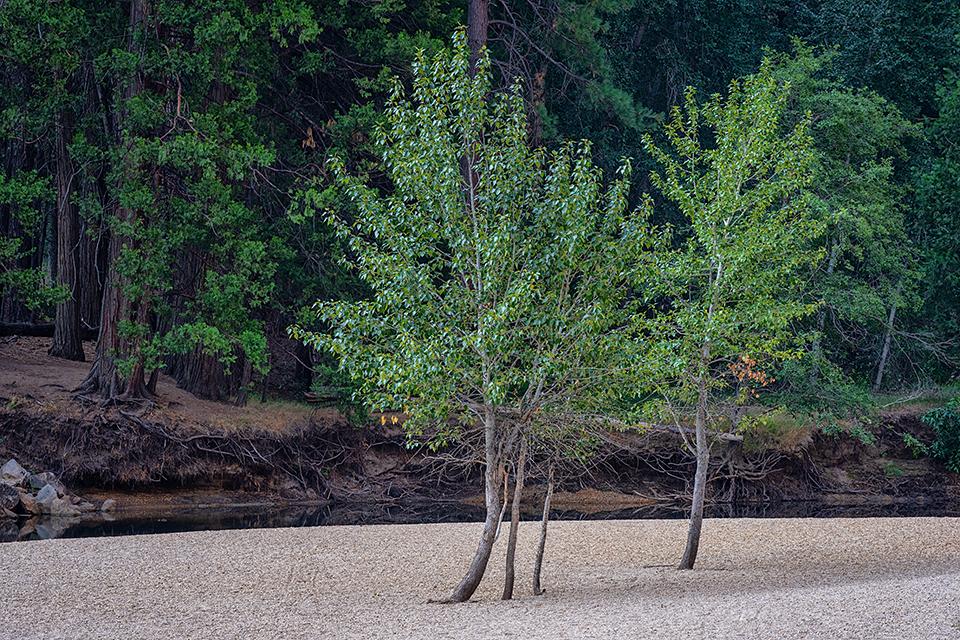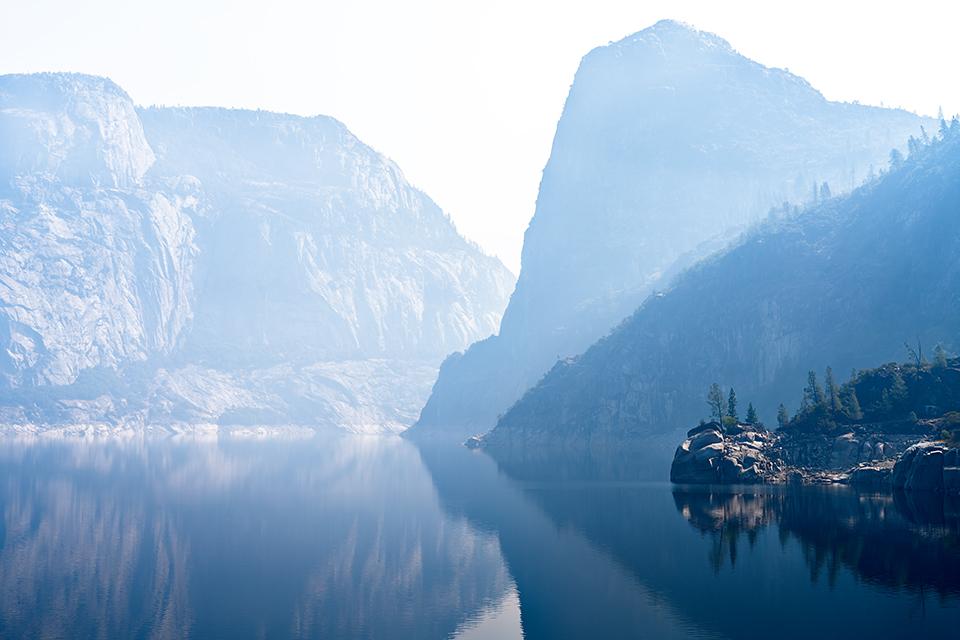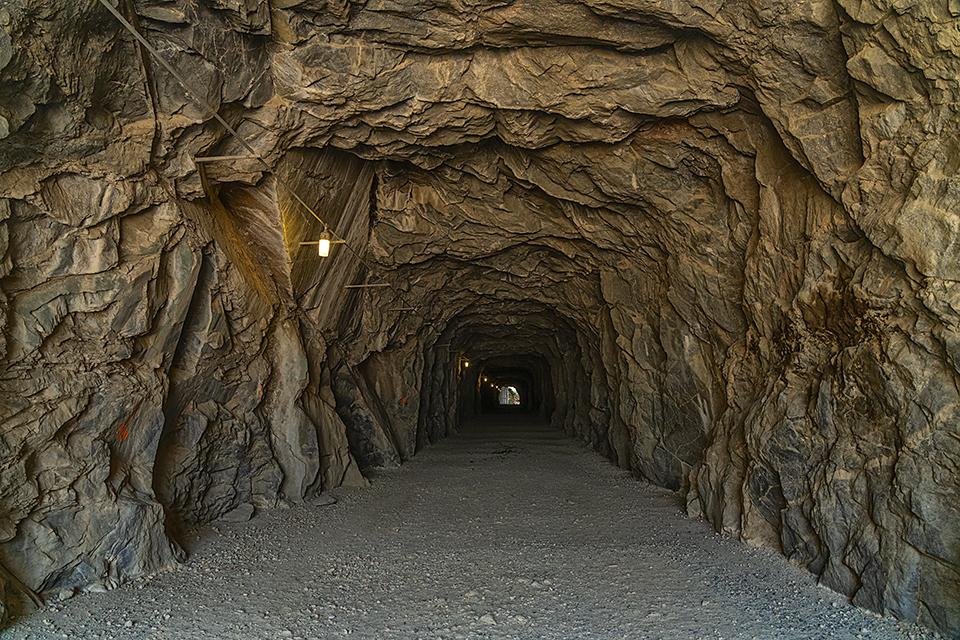
A hazy summer sunrise at Tunnel View, Yosemite National Park / Rebecca Latson
Not too long ago, I read a portion of an interview with a young and upcoming adventure landscape photographer who dismissively remarked that all the iconic spots were over-photographed and over-published and not worth any further attention (I’m paraphrasing here). My response was to roll my eyes and mutter “Whatever.” You see, I truly believe that, no matter how oft-photographed an iconic vista may be, you should still get a photo of that spot, if you are there. Why? For one thing, because you are the one capturing that particular composition, and for another, what the heck is wrong with getting a photo of an awe-inspiring location, even if a gazillion others have photographed the same vista? To paraphrase another photographer with whom I heartily agree, a popular spot for photography is like a great restaurant. You go there because the food is great and you’re not going to skip out on it because many others have eaten there.
I wanted my first view of, and introduction to, Yosemite National Park to be Tunnel View. Talk about iconic! And I wanted it to be a sunrise view. If you’ve ever looked at other sunrise shots of this location, you’ll know that sunrise may not be that dramatic. Didn’t matter to me. That’s what I wanted. Now, I’ve written this before, and I’ll write it here again: even an iconic view can look different on a daily or even hourly basis, because of the time of year, weather, and quality of light. On the morning I visited, the haze from area wildfire smoke diffused the light, creating a soft, saturated deep pink glow over the valley while silhouetting the rock formations. It only lasted a few moments, but I happened to be there during those moments to capture a sweet version of an iconic vista.

The Merced River and Yosemite Valley landscape, Yosemite National Park / Rebecca Latson
Due to my emergency eye surgery back in June, which is when I originally planned to visit this national park, I had to reschedule the trip and late August was the only time slot available. So, yeah, there I was, visiting Yosemite right in the middle of summer (late summer, actually) when the park was at its most-crowded and the atmosphere was hazy with wildfire smoke, and the waterfalls were pretty much bone-dry due to the season and drought conditions, and the Merced River was a mere trickle of its former self, yadda yadda. Sometimes, you just have to make do with what you are handed. I made do. I captured great shots of well-known places with my own cameras, but I also worked at finding new and different ways to compose shots of those tried-and-true vistas, in addition to framing images of less-photographed things.

Four trees on the beach at Swinging Bridge Picnic Area, Yosemite National Park / Rebecca Latson
After that sunrise shot, I drove further into the valley, stopping at Swinging Bridge Picnic Area. As I crossed the bridge (which didn’t swing, btw), I was struck by the sight of four trees growing from a bright, light-colored mix of sand and rocks framed in the background by a shadowy dark green. When something catches your eye, get the picture. For this image, I utilized the rule-of-thirds technique and placed the trees to the side, rather than the center, of the composition.

Bees in the Datura bloom, Yosemite National Park / Rebecca Latson
I continued my perambulation along the paved trail and found my eyes drawn into the distance, to a small patch of white flowers within a deeper green mass of leaves, all beneath the morning shade of trees towering above the flower patch. As I walked the trail closer to those flowers, they resolved themselves into the creamy ivory-colored trumpet shapes of datura (aka jimsonweed, thornapple, moonflower). The bees buzzed everywhere, so I zoomed in on a single flower backlit by the sun, where I could see the shadow of a bee inside the bloom.
Having never made the June trip to Sequoia and Kings Canyon national parks, I did the next best thing and hiked to one of the several trail-accessible giant Sequoia groves within Yosemite. My rental cabin was in the Wawona area, so I drove to the Mariposa Grove Welcome Plaza and took the trail to Mariposa Grove, reopened after the devastating mono wind event back in January 2021.

A tall Sequoia tree in Mariposa Grove, Yosemite National Park / Rebecca Latson
Since Sequoia trees are tall (no duh, right?), I wanted to capture their height like I did with the coastal redwoods in Redwood National and State Parks. I used my 11-24mm ultra-wide-angle lens and turned the camera to a vertical position. Ultra-wides are great for this kind of thing, but they do give one a unique, even funky, perspective of a scene, depending upon whether you move the camera and lens up or down with respect to your subject.

Grazing at El Capitan Meadow, Yosemite National Park / Rebecca Latson
On another day, on the way to Hetch Hetchy, I saw a small herd of deer grazing in El Capitan Meadow, with the Cathedral Rocks looming in the distance. Of course, I stopped for a vertical image of that single stag in the bright grass. The deer provided a sense of scale to the looming rock wall in the background. A vertical shot better emphasized the height of the granite wall and the diminutive size of the stag. No, I did not use an ultra-wide-angle lens for this shot.

Having driven into Yosemite Valley almost every day, and being cognizant of all the surrounding wildfires, I noticed the blackened, charred areas of trees just off the park road, indicating a past fire. Wow! I had no idea wildfires got this close into the valley, I thought to myself. It wasn’t until I later Googled it that I discovered burns in such places like the Sentinel Beach Picnic Area were prescribed burns to “reduce the heavy accumulation of dead and down fuels “. As I looked at the charred trees, I saw a certain symmetry created by the parallel blackened trunks. Yup, another photo. Remember: when something catches your eye, get a photo of it.

A boardwalk leading line through the meadow, Yosemite National Park / Rebecca Latson
One morning in Yosemite Valley, I parked and photographed the boardwalk over Cook’s Meadow (well, I think it was Cook’s Meadow). This boardwalk was the perfect leading line taking my eye from the park road toward the stand of trees and Merced River beyond. Trails and boardwalks make great leading line shots because they promise an unseen destination and adventure, if only you step upon the trail.

A look inside the historic Ahwahnee, Yosemite National Park / Rebecca Latson
A visit to this Yosemite is not complete without a wander through the Ahwahnee Hotel, historic lodging for celebrities and regular folk, and once used as a naval hospital during World War II. The beautiful polished interiors of this building beg for photographs to be captured. I used my 11-24mm ultra-wide-angle lens to get as much of each room as I could fit into the frame, although as mentioned earlier, the lens did tend to create interesting perspectives, depending upon whether I pointed it up or down in relation to the subject. And because most of the hotel’s interior tends to be dark, a higher ISO (640), more open aperture (f5.6), and slower shutter speed (1/30) are needed to capture as much of the ambient light as possible. Because I handheld the camera, I had to keep the shutter speed relatively “fast” in order to prevent camera shake blur. The burst method was helpful for this, too. “Burst method” means you hold your finger down on the shutter button for several clicks in order to capture at least one sharp, clear shot. Of course, the burst method uses up memory card space, so it’s always a good idea to carry plenty of spare cards with you. Perhaps I could have used a flash, but I find them to be intrusive and that flash of light can create sharp, dark shadows where you least want them. Besides, a flash usually only lights up an area immediately in front of the camera, and not all the way back of a large room.

The Hetch Hetchy Reservoir on a smoky day, Yosemite National Park / Rebecca Latson
I wanted to see as much of the park as possible, so after my Wawona and Yosemite Valley visits, I drove to the Hetch Hetchy Valley and O’Shaughnessy Dam. I’d already mentioned that sometimes, you have to make do with whatever you are given as a photographer. This day was one of those days: dry, hot, smoky. Staring out upon the reservoir from my position on the dam, I could barely see the distant landscape due to the haze, which created a white and blue cast to the entire vista, with different degrees of blue shade which gave the scene a layered look.

A different kind of tunnel view at Hetch Hetchy, Yosemite National Park / Rebecca Latson
Although I didn’t bother hiking from O’Shaughnessy Dam to Wapama Falls, since the falls were bone dry, I did, however, capture another leading line-sort of shot while walking through the tunnel and onto the trail leading to Wapama Falls. It’s an impressive little tunnel from the dam through the mountain, although I wished I’d brought along a small flashlight to help better light the uneven, rock-studded floor. The lights on the tunnel ceiling help some, but I almost tripped over a dark spot along the way.
A summer trip to Yosemite includes at least one drive along Tioga Road, from Crane Flat in the west to the park’s Tioga Entrance in the east (and beyond, if you feel like driving over and down Tioga Pass). In all honesty, this was my favorite part of the park: I was driving a high-elevation road (“peaking at just under 10,000 feet”) through the granite High Sierras with all sorts of geological evidence of past glacial activity on which to feast my eyes. Olmsted Point was, hands down, my favorite view area. I captured a different view of Half Dome (including a telephoto view of the teeny tiny climbers using the cables to ascend the last 400 feet of this mountain), remnants of glaciers and other erosional forces (erratics dropped off by receding ice, polished striations indicating the direction of glacial flow, weathered joints in the granite), and a distant view of Lake Tenaya encircled by high, pink-ish granite mountains.

Glacial erratics at Olmsted Point, Yosemite National Park / Rebecca Latson
In several of my Olmsted Point photos, I included people. Why? Because they were great examples of scale and reference compared to the immensity of the landscape.
I covered quite a bit of photographic territory during my week’s stay at Yosemite. Probably not as much as I would have liked, but it was enough for me during that time of year. If I ever return to this national park, it’s going to be either during the spring or much later in autumn, not only to highlight the seasonal differences, but to photograph what I didn’t capture during my first visit (gushing waterfalls and a roaring Merced River).

A Yosemite sunset, Yosemite National Park / Rebecca Latson
Despite the fact my visit coincided with haze from the wildfires, I’ll say one thing for the smoke wandering through the park: it sure made for some amazing sunsets. Sure, I captured a sunset one relatively clear evening at Tunnel View, but to be honest, it was not half as dramatic or colorful as the sunset I photographed at a long pullout heading back down Glacier Point Road, looking out toward the mountain landscape framing El Portal. Now that, was a sunset.

A ledge with a view at Glacier Point, Yosemite National Park / Rebecca Latson
Oh, before I forget, take my advice, here, and don’t forget to let serendipity lend a hand to your photography. Instead of focusing in on the Big Picture landscape at Glacier Point, I turned my camera toward that little squirrel on that jutting ledge with the great view. Actually, the squirrel was turned away from the view, probably trying to suss out which amongst the crowd might be the easiest mark to give it a snack (thankfully, I didn’t see anybody doing that).
While I photographed other locations not covered here (in the interest of article length), I hope what you do see in this month’s photo column encourages you to go out and photograph those iconic Yosemite locations for yourself, while observing other things around you for new perspectives within this national park.

A morning reflection of Cathedral Rocks at El Capitan Bridge, Yosemite National Park / Rebecca Latson



Comments
WOW!
As always, your photos are incredible, Rebecca.
And you must have been one very busy little girl. You covered virtually the entire park! Did you even stop for lunch?
Another great article - and some super photos to accompany it!! Thanks Rebecca!
And thank you, Chip, for all the kind words.